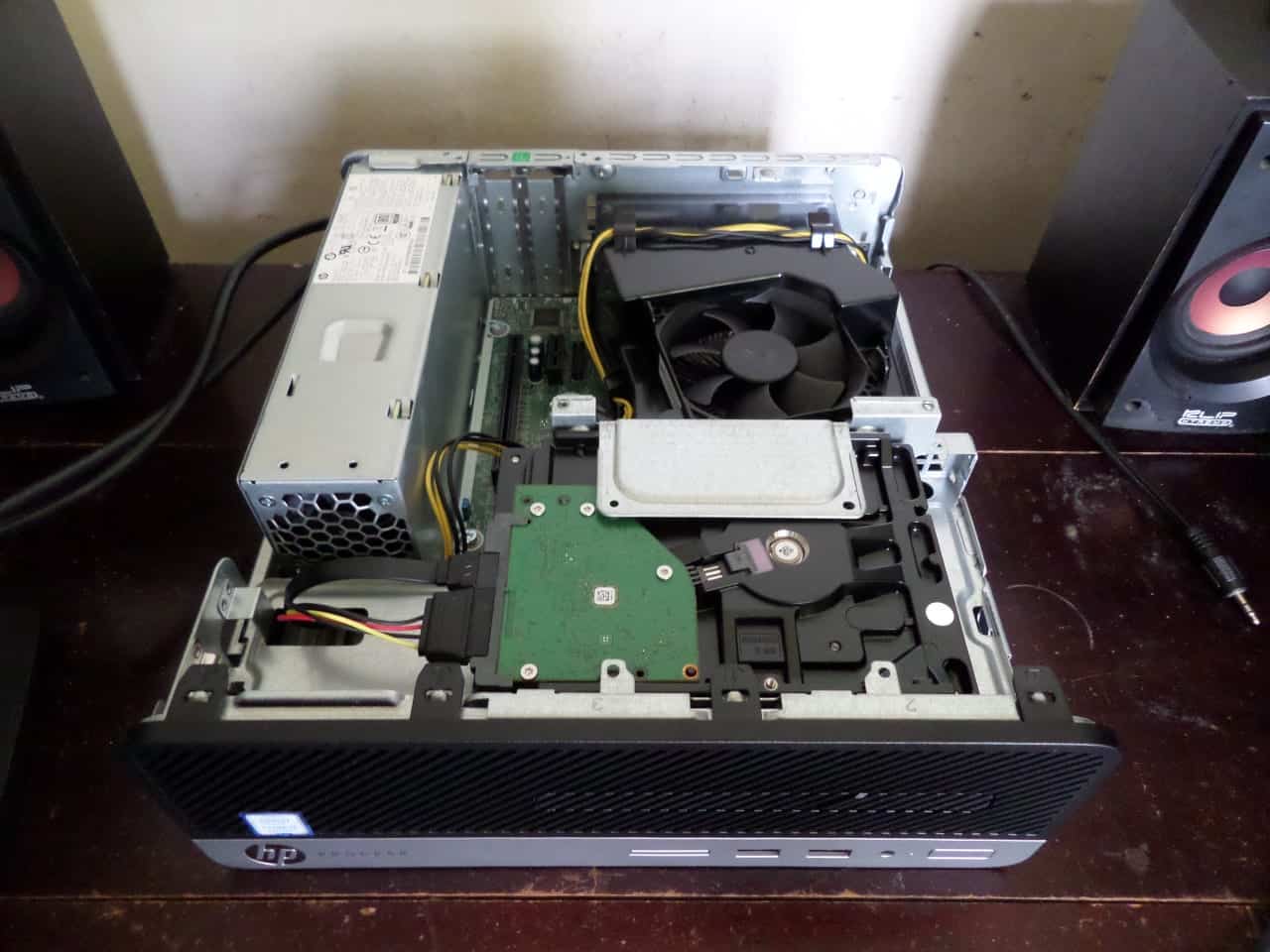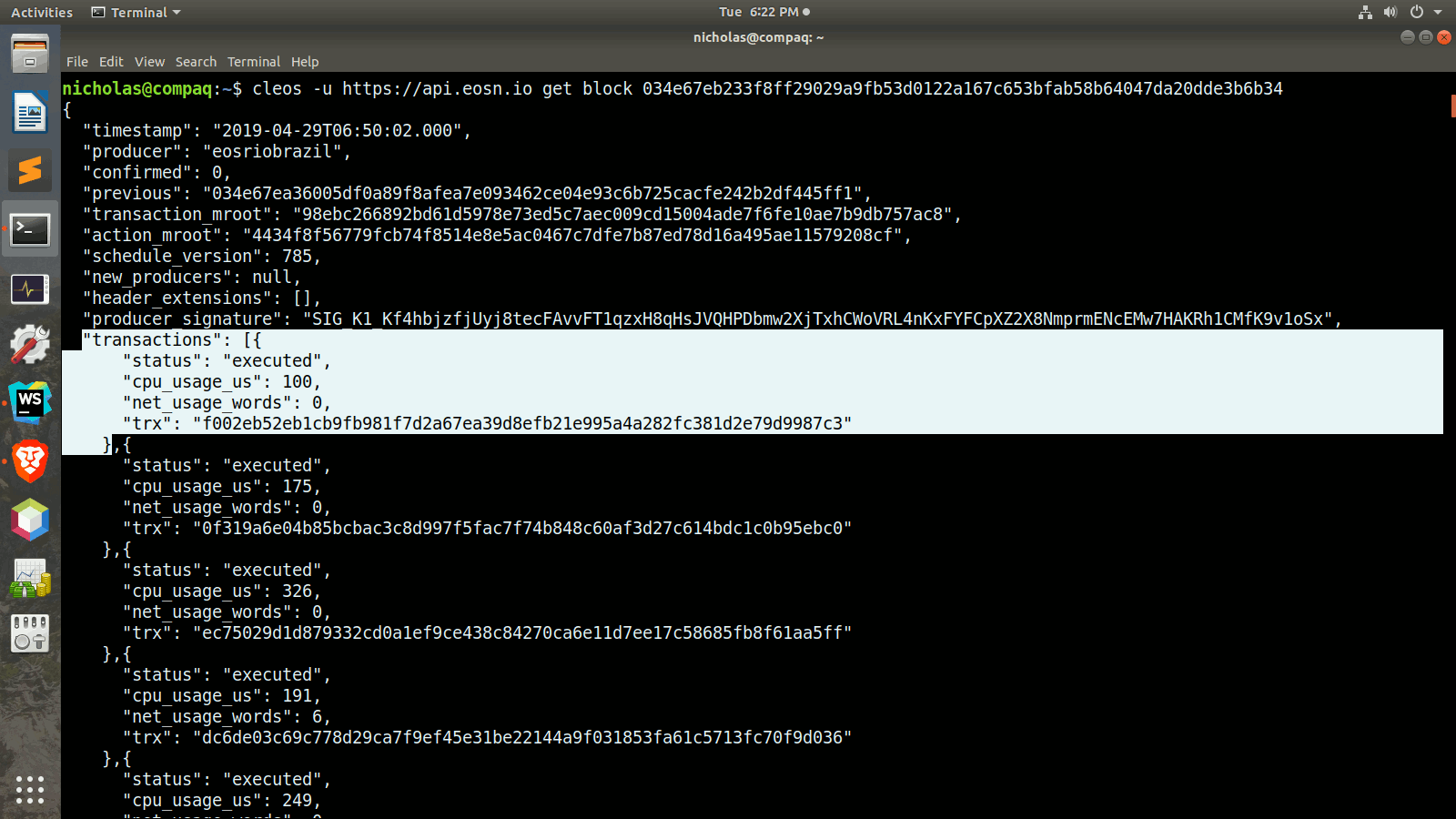The HP ProDesk 400 G5 is a small form factor (SFF) desktop PC for home or office use, but is advertised as a business desktop (as well) for demanding work environments. There are several different configurations of the ProDesk 400 G5 SFF with 8th generation Intel i3, i5, and i7 CPUs. However this tutorial covers specifically the 4BW88UT.
The rating scale I used in this article is:
- Poor.
- Fair.
- Good.
- Excellent.
- Superb.
Table Of Contents
| Chassis |
| Expansion |
| Is It Upgradable? |
| Cooling System And Thermal Performance |
| Performance |
| Ports |
Chassis
The tiny 27 cm-wide (10.6 inches) x 29.5 cm-long (11.6 inches) x 9.5 cm-tall (3.7 inches) PC is designed to either stand upright on your desk to reduce its own footprint on the desk, or to lay down flat like a 1980s-style PC so you can put your monitor and a few small things on top of it.
The chassis is a fairly conventional design with a sturdy metal frame and a somewhat-textured matte black finish. It has a plastic two-tone bezel (silver and black) at the front that causes the included DVD-RW drive to blend in with the rest of the case. The case opens in a matter of seconds by simply removing a single thumb screw at the back, then the top just slides right off to provide access to all the parts.
All air intake vents are at the front, and all air outlet vents are at the back of the case. This is actually useful if you want to stack these machines on top of each other or stand them up side-by-side in close proximity to each other — airflow won’t be obstructed unless you block the front or rear vents.
The only annoyance I experienced with the chassis is that it takes a little longer than i’m accustomed to access the RAM, because it is underneath the drive cage. So I had to press a little release tab and lift the drive cage up to upgrade the RAM. However, this is still terribly easy compared to upgrading a laptop or all-in-one PC’s RAM (it came with a free RAM slot, by the way).
Maintainability: Excellent.
Overall ease of access: Superb.
Expansion Of The ProDesk 400 G5 SFF
The 4BW88UT model in this article comes with two DDR4 RAM slots, and you can add quite a bit of RAM. I added 8GB of RAM to mine and it was the silver bullet I needed to run the numerous apps I use for app development in the background without a problem.
There is a single 3.5 inch drive bay, which is occupied by the included WD Blue 500GB 7200 rpm hard drive. That drive bay also provides the ability to install two 2.5 inch SSDs or 2.5 inch hard drives if you want to double up your storage. This entails removing the included 3.5 inch drive.
This ProDesk 400 G5 is also equipped with two M.2 slots. One for a wireless adapter, and the other is for an M.2 SSD. This is convenient because you can install the M.2 SSD to add storage (and boost performance) without having to remove the supplied 3.5 inch hard drive. There are also two PCI Express slots. One is a x4 and the other is a x16.
Aside from GPUs, upgradability isn’t really a problem unless you want to use several hard drives or more than two sticks of RAM (and you can get 16GB easily by just using two 8GB sticks). One upgrade i’m looking forward to for this model is a dual-antenna Wi-Fi PCI Express card! Some of them come with low-profile brackets to fit this PC perfectly.
ProDesk 400 G5 SFF GPU Upgrades
Your ability to upgrade the GPU in a PC is usually limited by something (heigh or depth, airflow, PSU wattage, among other things). However, in the case of this PC it is the power supply unit (PSU) and the chassis height. The PSU wattage (180W) is the primary issue here, as there are several low-profile GPUs out there that can fit it.
The amount of power available is only enough to accommodate a video card with a low power consumption (and these don’t contain high-end GPUs). The PSU should be upgradeable (I can’t confirm this, as I haven’t actually tried it) to one of a higher wattage.
ATX and microATX (uATX) chassis’ are significantly more expandable. However, it wouldn’t be fair to compare designs like these because they are designed specifically to save space. Everything serves a purpose!
Expandability rating: Fair compared to larger desktop chassis’, and Excellent for a chassis of its size.

Cooling And Thermal Performance
The ProDesk 400 G5 SFF comes in a small chassis, and that generally means that it has less room for cooling fans, and the height of the CPU heatsink is limited as well. The supplied heatsink keeps the included i3-8100 CPU in the 36-45 °C range at an ambient temperature of 32 °C. The CPU idles in the high 30s and early 40s (°C).
When I ran a few video rendering operations with Blender, the CPU temperature hovered in the 70-80 °C range, which is still within its temperature limits. The included 80mm fan never got too noisy. It became barely audible when the temperature hit 80° (the ambient temperature was in the high 20s).
The included heatsink is a fairly standard size for that CPU, which is likely why it achieved standard performance. The 80mm fan is also common for budget-to-midrange CPUs like the i3-8100 (these CPUs don’t generate too much heat). Overall, the PC has been quiet the entire time i’ve had it (7 months), even when I maxed it out completely with demanding games.
The CPU fan doubles as the chassis fan because it is shrouded and its outlet (which is the heatsink outlet) is vented directly through the back of the case. This helps to compensate for the small case by immediately dumping the CPU’s hot air outside the PC, instead of dumping inside the PC (heating up the other parts) and relying on a separate case fan to exhaust that hot air.
So my thermal performance rating for this model is: Excellent.
Also read: My Thermaltake Luna 12 cooling fan review
CPU, GPU And Overall Performance Of The ProDesk 400 G5 SFF
The performance of this PC and desktop PCs in general is mostly dependent on the parts included (although poor thermal performance can cause CPU throttling, watch out for cheaper computers!). The ProDesk 400 G5 SFF models are offered with a broad variety of processors ranging from the budget Intel Celeron, to an exceptionally powerful i7-8700.
Mine came with 4GB of RAM and I would immediately say that you’ll want more RAM. I installed an 8GB $35 stick rather quickly because 4GB of RAM is not enough. It has 12GB now and that made a world of a difference. If you’re just responding to emails and won’t have many browser tabs open or be doing any considerable amount of multitasking, then 4GB will do.
If you are a software developer, a social media manager with numerous tabs open, a gamer, are editing video, or are editing extremely large spreadsheets — you’ll need far more RAM. Thankfully, a substantial RAM upgrade from 4GB to 12GB costs $30 to $40 depending on the brand of RAM you purchased.
Overall, I have been running Android Studio, PostgreSQL server, MongoDB, several browser tabs, and 3 instant messengers all at the same time without it slowing down much or encountering any other performance issues. I also wrote an article about some games I played on it, and how they ran (including the popular Counterstrike: Global Offensive).
The GPU is a budget-friendly Intel HD 630, which is for basic everyday activities — not gaming or video editing (although some games and light video editing are possible, but you won’t get the best frame rates).
Ports
This model comes with 8 USB ports (two of them are at the front), one Ethernet port (gigabit Ethernet adapter), 1 DisplayPort, standard 3.5mm microphone and audio output ports, and 1 VGA port. There are other optional ports available (such as HDMI), but those are dependent on configuration.
Bundled software
I’m going to admit that I didn’t try using most of the software that was bundled with this PC. However, I didn’t need it and ended up installing Ubuntu Linux for its security, the control it offers me over my own PC, and stability. The PC was shipped with Windows 10 Professional, which comes with Bitlocker (this is good, as encryption is essential for the protection of sensitive information and should really be available as an option for all PCs by now).
Overall stress and frustration caused by this PC: Low/Superb. I haven’t had a single reliability issue with it.
The HP Recovery Media creation failed, though. I don’t understand why. However, you can download the Windows 10 recovery media creator from Microsoft, and Microsoft will let you download a fresh copy of Windows 10.
The PC also came with some other little features and perks common in business PCs such as a TPM chip (Trusted Platform Module, a form of cryptoprocessor), padlock slot, and a ‘gold’ rated 180W Flex ATX power supply.








